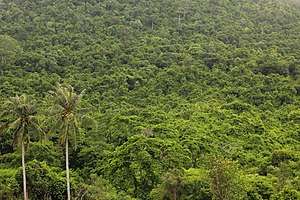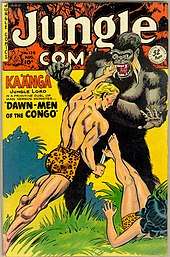Jungle
A jungle is land covered with dense forest and tangled vegetation, usually in tropical climates. Application of the term has varied greatly during the past recent centuries. Before the 1970s, tropical rainforests were generally referred to as jungles, but this terminology has fallen out of usage.

Etymology
The word jungle originates from the Sanskrit word juṅgala (Sanskrit: जङ्गल), meaning rough and arid. It came into the English language via Hindi in the 18th century.[1][2] Jāṅgala has also been variously transcribed in English as jangal, jangla, jungal, and juṅgala. Although the Sanskrit word refers to dry land, it has been suggested that an Anglo-Indian interpretation led to its connotation as a dense "tangled thicket"[3] while others have argued that a cognate word in Urdu did refer to forests.[4] The term is prevalent in many languages of the Indian subcontinent, and the Iranian Plateau, where it is commonly used to refer to the plant growth replacing primeval forest or to the unkempt tropical vegetation that takes over abandoned areas.[5]
Wildlife
Because jungles occur on all inhabited landmasses and may incorporate numerous vegetation and land types in different climatic zones, the wildlife of jungles can not be straightforwardly defined.
Varying usage
As dense and tangled vegetation

One of the most common meanings of jungle is land overgrown with tangled vegetation at ground level, especially in the tropics. Typically such vegetation is sufficiently dense to hinder movement by humans, requiring that travellers cut their way through.[6][7][8] This definition draws a distinction between rainforest and jungle, since the understorey of rainforests is typically open of vegetation due to a lack of sunlight, and hence relatively easy to traverse.[9][10] Jungles may exist within, or at the borders of, rainforests in areas where rainforest has been opened through natural disturbance such as hurricanes, or through human activity such as logging.[6][11][12] The successional vegetation that springs up following such disturbance of rainforest is dense and tangled and is a ‘typical’ jungle. Jungle also typically forms along rainforest margins such as stream banks, once again due to the greater available light at ground level.[9]
Monsoon forests and mangroves are commonly referred to as jungles of this type. Having a more open canopy than rainforests, monsoon forests typically have dense understoreys with numerous lianas and shrubs making movement difficult,[6][13][14] while the prop roots and low canopies of mangroves produce similar difficulties.[15][16]
As moist forest
Because European explorers initially travelled through tropical rainforests largely by river, the dense tangled vegetation lining the stream banks gave a misleading impression that such jungle conditions existed throughout the entire forest. As a result, it was wrongly assumed that the entire forest was impenetrable jungle.[17][18] This in turn appears to have given rise to the second popular usage of jungle as virtually any humid tropical forest.[19] Jungle in this context is particularly associated with tropical rain forest,[8][20] but may extend to cloud forest, temperate rainforest, and mangroves[19][21] with no reference to the vegetation structure or the ease of travel.
The word "rainforest" has largely replaced "jungle" as the descriptor of humid tropical forests, a linguistic transition that has occurred since the 1970s. "Rainforest" itself did not appear in English dictionaries prior to the 1970s.[22] The word "jungle" accounted for over 80% of the terms used to refer to tropical forests in print media prior to the 1970s; since then it has been steadily replaced by "rainforest",[23] although "jungle" still remains in common use when referring to tropical rainforests.[22]
As metaphor

As a metaphor, jungle often refers to situations that are unruly or lawless, or where the only law is perceived to be "survival of the fittest". This reflects the view of "city people" that forests are such places. Upton Sinclair gave the title The Jungle (1906) to his famous book about the life of workers at the Chicago Stockyards, portraying the workers as being mercilessly exploited with no legal or other lawful recourse.[24]
The term "The Law of the Jungle" is also used in a similar context, drawn from Rudyard Kipling's The Jungle Book (1894)—though in the society of jungle animals portrayed in that book and obviously meant as a metaphor for human society, that phrase referred to an intricate code of laws which Kipling describes in detail, and not at all to a lawless chaos.
The word "jungle" itself carries connotations of untamed and uncontrollable nature and isolation from civilisation, along with the emotions that evokes: threat, confusion, powerlessness, disorientation and immobilisation.[23][25][26] The change from "jungle" to "rainforest" as the preferred term for describing tropical forests as has been a response to an increasing perception of these forests as fragile and spiritual places, a viewpoint not in keeping with the darker connotations of "jungle".[23][27][28]
Cultural scholars, especially post-colonial critics, often analyse the jungle within the concept of hierarchical domination and the demand western cultures often places on other cultures to conform to their standards of civilisation. For example: Edward Said notes that the Tarzan depicted by Johnny Weissmuller was a resident of the jungle representing the savage, untamed and wild, yet still a white master of it;[29] and in his essay "An Image of Africa" about Heart of Darkness Nigerian novelist and theorist Chinua Achebe notes how the jungle and Africa become the source of temptation for white European characters like Marlowe and Kurtz.[30]
Former Israeli Prime Minister Ehud Barak compared Israel to "a villa in the jungle" - a comparison which had been often quoted in Israeli political debates. Barak's critics on the left side of Israeli politics strongly criticised the comparison. For example, Uri Avnery charged that comparing "civilised" Israel with "a villa" and Israel's Arab neighbors with the "wild beasts" of the "jungle" tends to throw the blame for the absence of peace on the "wild" Arab and Palestinian side, and absolve Israel of responsibility.[31][32][33]
See also
- Monsoon forest
- Arid Forest Research Institute (AFRI)
- Rainforest
- Wilderness
- Tropical vegetation
References
- "Meaning of jungle in English". Lexico. Oxford University Press/Dictionary.com. 2020. Retrieved 11 June 2020.
Origin: Late 18th century via Hindi from Sanskrit jāṅgala ‘rough and arid (terrain)’.
- "Home : Oxford English Dictionary". www.oed.com. Retrieved 2019-04-01.(subscription required)
- Francis Zimmermann (1999). The jungle and the aroma of meats: an ecological theme in Hindu medicine. Volume 4. Motilal Banarsidass. ISBN 81-208-1618-8.
- Dove, Michael R. (1992). "The Dialectical History of 'Jungle' in Pakistan: An Examination of the Relationship between Nature and Culture". Journal of Anthropological Research. 48 (3): 231–253.
- Yule, Henry, Sir (1903). Hobson-Jobson: A glossary of colloquial Anglo-Indian words and phrases, and of kindred terms, etymological, historical, geographical and discursive. New ed. edited by William Crooke, B.A. J. Murray, London. Archived from the original on 2012-07-07.CS1 maint: multiple names: authors list (link)
- Tropical Forests Archived 2012-10-10 at the Wayback Machine
- Mysterious Journey Archived 2012-07-02 at the Wayback Machine
- Nygren, A. 2006 Representations of Tropical Forests and Tropical Forest-Dwellers in Travel Accounts of ‘National Geographic', Environmental Values 15
- "Tropical Wet Realms Of Central Africa, Part I".
- "Rainforest Biomes". www.blueplanetbiomes.org.
- Kricher JC. 1997. A neotropical companion: an introduction to the animals, plants, and ecosystems of the New World tropics, 2nd edn. New Jersey: Princeton University Press.
- Ecology L4.OO Archived 2012-07-03 at the Wayback Machine
- http://www.u.arizona.edu/~jrjurjev/Geo101_files/Forest_Biome[1][1].ppt
- "Terrestrial Biomes" (PDF). Wku.edu (Western Kentucky University, Department of Geography and Geology). Archived from the original (PDF) on May 27, 2013. Retrieved November 29, 2012.
- Holguin, G. Guzman, M.A. &Bashan, Y. 1992 Two new nitrogen-fixing bacteria from the rhizosphere of mangrove trees: Their isolation, identification and in vitro interaction with rhizosphere Staphylococcus sp. FEMS Microbiology Ecology 101
- Namdar, A. & Nusrath, A. 2010 Tsunami numerical modeling and mitigation. Frattura ed Integrità Strutturale 12
- Sterling, T. (1983). The Amazon: The World's Wild Places. Time-Life Books. New York
- Baumann, Paul R. (2009). "Tropical Wet Realms of Central Africa, Part 1". Oneonta.edu (State University of New York College at Oneonta). Retrieved November 29, 2012.
- Purser, B. 2003. Jungle bugs: masters of camouflage and mimicry. Firefly Books, Toronto.
- Birtles, T. G. 1997: "First contact: colonial European preconceptions of tropical Queensland rainforest and its people". Journal of Historical Geography 23, 393–417.
- M\Iyengar, M. O. T. 1930 Jungle in Relation to Malaria in Bengal. Indian Journal of Medical Research 18:1
- Rogers, C. 2012 Jungle Fever: Exploring Madness and Medicine in Twentieth-Century Tropical Narratives. Vanderbilt University Press, Nashville. ISBN 9780826518316.
- Slater, C (2003). In Search of the Rain Forest. Duke University Press
- Miller, David Cameron (1989). Dark Eden: the swamp in nineteenth-century American culture. Volume 43 of Cambridge studies in American literature and culture Structural Analysis in the Social Sciences. Cambridge University Press. ISBN 0-521-37553-3.
- Fearing, F. (1963) "The problem of metaphor" Southern Journal of Communication
- Jones, J. (1962) "The Thin Red Line". Dell Publishing New York
- Slater, C (2004). Marketing the ‘rain forest’: Raw Vanilla fragrance and the ongoing transformation of the jungle. Cultural Geographies 11:4
- Gustavson, E. 2007 "Rhetoric: How Politicians Manipulate Language and the Media to Shape Public Thought" Hinckley Journal of Politics 8
- Said, Edward W. (2000). "Jungle Calling". Reflections on Exile: And Other Essays. Convergences Series. Harvard University Press. ISBN 9780674003026.
- Chinua, Achebe (1977). "An Image of Africa: Racism in Conrad's 'Heart of Darkness'". Massachusetts Review (18 ed.).
- Uri Avnery, "Barak: A Villa in the Jungle", Gush Shalom website, July 7, 2007 ,
- Akiva Eldar, "The price of a villa in the jungle", Ha'aretz, Jan. 30, 2006
- Larry Derfner, "Ehud Barak to step down: On his de-evolution, and Israel's", +972 Magazine, November 26, 2012
External links
| Wikimedia Commons has media related to Jungles. |
| Look up jungle in Wiktionary, the free dictionary. |